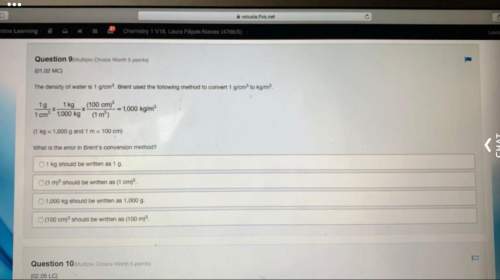
Chemistry, 17.02.2021 01:00 Jenifermorales101
1. Electronegativities of the elements Be, Mg, Ca, and Sr follow a specific trend within their group. Based on this trend, the atoms of which element will have the least attraction for an electron?
A) Be.
B) Mg.
C) Ca.
D) Sr.
2. Which element has a larger atomic radius than sulfur?
A) Chlorine.
B) Cadmium.
C) Fluorine.
D) Oxygen.
3. Which ion was formed by providing the second ionization energy to remove an electron?
A) Ca2+.
B) N3–.
C) Fe3+.
D) S2–.
4. The most negative electron affinity is most likely associated with which type of atoms?
A) Large nonmetal atoms.
B) Small nonmetal atoms.
C) Large metal atoms.
D) Small metal atoms.
5. Selected properties of antimony (Sb) and iodine (I) are listed in the table below.
Element AtomRadius(pm) 1st IonEnergy(kJ/mol) ElectroAffinity(kJ/mol) Electronegative
Sb 145 ? –103 2.05
I 140 1008 –295 ?
Which predictions can most likely be made?
Sb has a lower ionization energy but a higher electronegativity than I.
Sb has a higher ionization energy but a lower electronegativity than I.
Sb has a lower ionization energy and a lower electronegativity than I.
Sb has a higher ionization energy and a higher electronegativity than I.
6. Which correctly summarizes the trend in electron affinity?
A) It tends to be very high for group 2.
B) It tends to be more negative across a period.
C) It tends to remain the same across periods.
D) It tends to be more negative down a group.
7. Which explains the change in ionization energy that occurs between removing the first and second electrons from an atom?
A) The ionization energy decreases because the ratio of the protons to electrons increases.
B) The ionization energy increases because the ratio of the protons to electrons increases.
C) The ionization energy decreases because the ratio of the protons to electrons decreases.
D) The ionization energy increases because the ratio of the protons to electrons decreases.
8. Which element would most likely have an electron affinity measuring closest to zero?
A) Na.
B) Al.
C) Rb.
D) Ar.
9. Electronegativities of the elements Na, Al, P, and Cl follow a specific trend across the period. Based on this trend, an electron will be most strongly attracted to
A) Na.
B) Al.
C) P.
D) Cl.
10. Which best describes ionization energy?
A) Energy needed to add an electron to a neutral atom in the gas phase.
B) Energy needed to add an electron to a neutral atom in the liquid phase.
C) Energy needed to remove an electron from an atom or ion in the gas phase.
D) Energy needed to remove an electron from an atom or ion in the liquid phase.

Answers: 2
Another question on Chemistry

Chemistry, 22.06.2019 18:00
An object displaces 652 ml of water. the volume of the object is: 0.652 cm³ 6.52 cm³ 65.2 cm³ 652 cm³
Answers: 2

Chemistry, 22.06.2019 19:30
Awoman's basketball has a circumference between 28.5 and 29.0 inches and a maximum weight of 20 ounces (two significant figures). what are these specifications in units of centimeters and grams?
Answers: 2

Chemistry, 22.06.2019 21:00
Read "who built the pyramids? ”. leave this link open while you answer the questions throughout the assignment. give at least two reasons why some people claim the pyramids of giza were constructed by aliens.
Answers: 1

Chemistry, 22.06.2019 22:30
Draw the aromatic compound toluene (methylbenzene). show all hydrogen atoms, including those on the ring.
Answers: 1
You know the right answer?
1. Electronegativities of the elements Be, Mg, Ca, and Sr follow a specific trend within their group...
Questions

Social Studies, 05.05.2020 17:13





Chemistry, 05.05.2020 17:13


English, 05.05.2020 17:13



Mathematics, 05.05.2020 17:13


History, 05.05.2020 17:13


Computers and Technology, 05.05.2020 17:13








